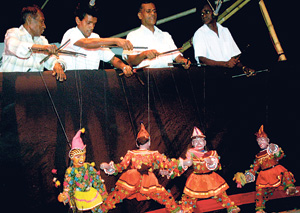D.S. Dharmasiri’s hands have grown rough manipulating the string puppets, many weighing up to six kilos each but at the age of 76, he has not lost the rhythm nor the flexibility needed to keep an audience enthralled by the variety of movements that a puppet performs.
Dharmasiri began performing as a puppeteer at the age of eight, the third generation in a family of performers hailing from Ambalangoda, the traditional centre of the puppeteers and mask makers in the country.
“I have been involved with puppet theatre for nearly 70 years now and even at this age I perform because of my love for it,” said Dharmasiri after the performance of the “Saraswathi Vandanawa’ one of the hallmarks of a puppet show.
“A puppeteer not only has to learn to work the movements of the puppet but also dance, sing and deliver dialogues as part of his performance. People usually see only the puppets in movement but don't see the hard work that goes on behind the scenes,” he said.
Puppet theatre in Sri Lanka dates back several centuries and has been a much-loved source of entertainment to young and old over the years. But today this unique form of art is dying out with little state patronage to uplift the living and working conditions of the puppeteers who are fighting an uphill battle to preserve their art for future generations.
A visit backstage at the show that a group of puppeteers from several areas in the country put on to mark the launch of a website to promote Sri Lankan puppetry reveals the hard work that goes into coordinating the movements of the puppets so that they are in sync with the background music as well as the singing.
Dharmasiri, who was honoured with the title of “Kala Booshana” by President Ranasinghe Premadasa, like many of the traditional puppeteers still engaged in this trade is not optimistic about their future. “There is little or no state patronage for us. While other forms of art are being promoted, we are being neglected,” he said.
Nalin Gamvary is a third generation puppeteer hailing from the most prominent family of puppet artists from Ambalangoda. His grandfather Gamvary Podisirina Gurunnanse was the founder of the present clan of puppeteers in the country who have now spread out into several areas such as Kandy and Matara.
He too is pessimistic about the future of this special form of art which his forefathers started and which he and his siblings have preserved till this day.
“My brothers and I have safeguarded what was handed down from my grandfather to my father then onto me but I fear that after my generation, this form of art will die out in Sri Lanka,” he said.
Most puppet artists today make a living by engaging in various other forms of self employment due to the lack of interest shown by concerned authorities to promote their art both locally as well as internationally. Nalin makes puppets to sell to tourists to make a living while public performances are becoming fewer and fewer.
“I have had the opportunity in the 1990s to visit several countries like Japan and Australia and my performances were very well received there but the kind of patronage those countries give to their traditional arts and artists does not happen here,” he lamented.
By way of welfare, the government has floated a pension scheme but it will only be implemented in five years. “By the time the pension scheme gets going, many of us may be no more,” Nalin said.
The website www.puppetrylk.com to promote Sri Lanka puppetry was initiated by Rohana Deva Perera, an executive committee member of the Arts Council of Sri Lanka and Chairman of the Thidora-Theatre Institute for Disability Oriented Research and Advocacy.
“There is an enormous amount of talent among the puppet artists in the country but economically they are downtrodden. What is needed is to make their medium of art economically viable by prompting them and getting them the necessary opportunities,” Rohana said.
He hopes the launch of the website from which many can access the work of the puppeteers will lead to a better understanding of puppetry in Sri Lanka and also get them the necessary international exposure. |


